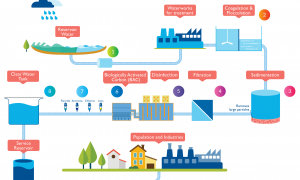🕑 Reading time: 1 minute
Dams are solid barriers constructed across a river or a natural stream to create an artificial reservoir on its upstream side for storing water. It may also be constructed to facilitate diversion of water from the river or to retain debris flowing in the river.Contents:
Facts on Dams
- The first known dams were constructed about 8,000 years ago in Mesopotamia
- Dams built in Jordan and Egypt – 1100BC
- Dujiang Irrigation Project in China – 300BC - 800,000 hectares
- Large Dams in the world (> 15 m high)
- In 1949 some 5,000 Existed.
- By 2000, there were 45,000.
- With the exception of the Great Wall of China, dams are the largest structures ever built
- Throughout history, big dams have prevented flooding, irrigated farmland, and generated tremendous amounts of electricity.
Purpose of the Dams
The main purpose of construction of dam is for,- Irrigation
- Generation of Electrical Energy
- Municipal and Industrial Water Supply
- Navigation
- Flood Control
- Recreation
- Diversion
- Catching and retaining debris
Major dams in the world and its roles
1. Tailings Dam, River Rimac, Peru
The Antamina Tailings Dam, is a tailings dam located in Huaraz in the Ancash Region of Peru. The purpose of the dam is to store tailings processed at the nearby Antamina mine. The dam was designed by Golder Associates, Burnaby, B.C. and Ingetec SA between 1998 and 1999. Construction on the 130 m (427 ft) high concrete-face rock-fill starter dam began in 2000 was complete in April 2001. The original elevation of the dam was 4010 m, in 2013 it was raised to 4045 m.
Fig 1: Tailings Dam, River Rimac, Peru
Role
As this dam is locate on the tail of a Antamina mine, its role is to hold all the tailings coming down the mine. The reservoir is lined with a geo membrane which controls seepage of tailings into the environment.2. Kariba Dam, Zimbabwe
The Kariba Dam is a double curvature concrete arch dam in the Kariba Gorge of the Zambezi river basin between Zambia and Zimbabwe. The dam stands 128 metres (420 ft) tall and 579 metres (1,900 ft) long. The Kariba Dam supplies 1,626 megawatts (2,181,000 hp) of electricity to parts of both Zambia and Zimbabwe and generates 6,400 gigawatt-hours per annum.
Fig 2: Kariba Dam, Zimbabwe
Role
- Water Supply
- Energy Generation
- Large Area Inundated
- Change in Fish
3. Vajont – Erto E Casso, Italy
This dam was touted as ‘The Tallest Dam in the World’ while it was being constructed, and it still remains one of the tallest coming it at 860 feet. On 9 October 1963, during initial filling, a massive landslide caused a man-made mega tsunami in the lake in which 50 million cubic metres of water overtopped the dam in a wave 250 metres (820 ft) high, leading to 1,910 deaths and the complete destruction of several villages and towns.
Fig 3: Vajont – Erto E Casso, Italy
4. Three Gorges Dam - China
The Three Gorges Dam is a hydroelectric gravity dam that spans the Yangtze River by the town of Sandouping, Hubei province, China. The Three Gorges Dam is the world's largest power station in terms of installed capacity (22,500 MW). In 2014, the dam generated 98.8 terawatt-hours (TWh) and had the world record, but was surpassed by the Itaipú Dam, which set the new world record in 2016, producing 103.1 TWh.
Fig 4 : Three Gorges Dam - China
Role
- Energy Generation
- Enhancing Navigation
- Flood Control
- 1,000,000 People Displaced
5. The Inguri Dam – Jvari, Georgia

Fig 5: The Inguri Dam – Jvari, Georgia
Role
- Energy Generation
- Large Area Inundated
- Change in Fish
6. Itaipu Dam in Brazil
Itaipu Hydroelectric Dam is the largest operational hydroelectric energy producer in the world, with an installed generation capacity of 14GW. The plant is operated by Itaipu Binacional and located on the border between Brazil and Paraguay. Energy generated by Itaipu helps meet demands from the two countries. About 90% of the energy generated by the plant is used by Brazil.
Fig 6: Itaipu Dam in Brazil
Role
- Energy Generation
- Irrigation Purpose
- Water Supply


